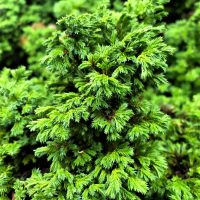Winter Interests (Part II) at the Washington Park Arboretum

1) Chamaecyparis pisifera ‘Plumosa Compressa’ Dwarf Sawara Cypress
This cultivar of the Japanese native, Sawara Cypress, has soft blue-green foliage.
Growing only one to six inches per year, this 50 year-old specimen can be seen just at the entrance to the Graham Visitors Center along Arboretum Drive.
2) Corylus maxima ‘Atropurpurea Superba’ Purple Giant Filbert
This cultivar of the Giant Filbert, or Hazel, produces long red male catkins in winter before the bright red young leaves emerge.
Read moreUW Botanic Gardens Director, Fred Hoyt, to Retire

Fred Hoyt, UW Botanic Gardens Director and Orin and Althea Soest Chair for Urban Horticulture, has announced he will retire at the end of January, 2021. Please join us in showing our appreciation for Fred’s service and congratulating him on his retirement.
Read moreHappy Holidays from Your UWBG Horticulture Staff!

We invite you to enjoy our “Game of Groves”.
Can you name the following iconic tree groves based on the photos shown and hints below?
#1)
I am a grove of nine broadleaf evergreen trees with berries that are commonly used as Christmas greens. My location is an “island” in the middle of the ocean surrounding our five Pacific Rim flora.
Selections from the New Zealand Garden at the Washington Park Arboretum

1) Coprosma propinqua Mingimingi
Coprosma is a genus of about 90 species of shrubs and trees found in various Pacific regions, including New Zealand and Australia. They range from trees to low-growing spreading shrubs and those with a divaricating habit.
A member of the plant family Rubiaceae, C. propinqua is found in swampy areas and near streams throughout New Zealand. The leaves are very small and oblong and the berries are a translucent blue color.
The Purples and Reds of Fall from the Home of UWBG Horticulturist, Annie Bilotta

1) Forsythia Common name: Forsythia or Easter Tree
A staple of many gardens, it is a harbinger of spring with its early yellow blossoms. It also provides some very nice fall color, extending its garden interest.
A member of the Olive family, Oleaceae.
Nicknamed the Easter Tree because it blooms around Easter time in early spring.
There are approximately 14 species, mostly from Asia.
UW Farm “Dig In” Fun-draiser October 28th!

UW Farm Hosting “Dig In!” Fun-draiser October 28th
Every year the UW Farm hosts a Farm To Table dinner to celebrate the end of the growing season, share stories, and hear from the seasonal student staff about their experiences, ask for donations, and dine on a delicious menu featuring UW farm Produce.
This year, because we cannot hold a large public in-person event, we are hosting a virtual, live evening event 7pm-8:15pm, Wednesday October 28th with Master of Ceremonies, Eli Wheat, of SkyRoot Farm, UW lecturer in College of the Environment and one of the founders of the UW Farm.
Restoration after Wildfires

Rare Care is assisting the Bureau of Land Management (BLM) with developing a site management plan that will help guide restoration and management of a population of Whited’s milk-vetch’s on BLM land that was impacted by recent fires.
Read more“Barking up the Right Tree”

1) Stewartia monadelpha Orange Bark Stewartia
Stewartia monadelpha is a small tree (up to 25 feet high) with stunning cinnamon bark.
A member of the Camellia family, the white flowers resemble those of small, simple Camellias and can be viewed in early summer.
Several beautiful specimens can be viewed at the southern end of the Camellia Collection.
2) Lagerstroemia indica x fauriei ‘Muskogee’ Muskogee Crepe Myrtle
This garden hybrid was developed by the National Arboretum in Washington, D.C.
Read moreOctober 2020 Plant Profile: Blechnum penna-marina

Despite not having showy flowers this demure evergreen fern deserves to be grown in more Northwest gardens.
Read moreThank you, volunteers!

Volunteers are an incredibly important part of the UW Botanic Gardens family. We made a video to tell our volunteers just how much we appreciate and miss them.
Read more